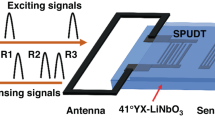Abstract.
Hyperbranched polyesters (HBP) with different end groups (P-OH, P-COOH, P-OAc) were prepared as thin films. Their surface properties were investigated using zeta potential and contact angle measurements. The differences in surface properties between P-OH and P-COOH, on the one hand, and P-OAc, on the other hand, predicted different behavior in sensoric applications. Therefore, the vapor of the homologous series of alcohols from methanol to pentanol was exposed to the thin films. Changes in thickness were observed with reflectometric interference spectroscopy (RIfS). First investigations in a current analytical problem for the detection and discrimination of refrigerants (freons) using P-OH as sensitive layer have been shown. Polydimethylsiloxane (PDMS) and poly(ether urethane) (PUT) were used as reference sensor materials for the RIfS measurements.
Similar content being viewed by others
Author information
Authors and Affiliations
Additional information
Electronic Publication
Rights and permissions
About this article
Cite this article
Belge, G., Beyerlein, D., Betsch, C. et al. Suitability of hyperbranched polyester for sensoric applications – investigation with reflectometric interference spectroscopy. Anal Bioanal Chem 374, 403–411 (2002). https://doi.org/10.1007/s00216-002-1496-3
Received:
Revised:
Accepted:
Issue Date:
DOI: https://doi.org/10.1007/s00216-002-1496-3




